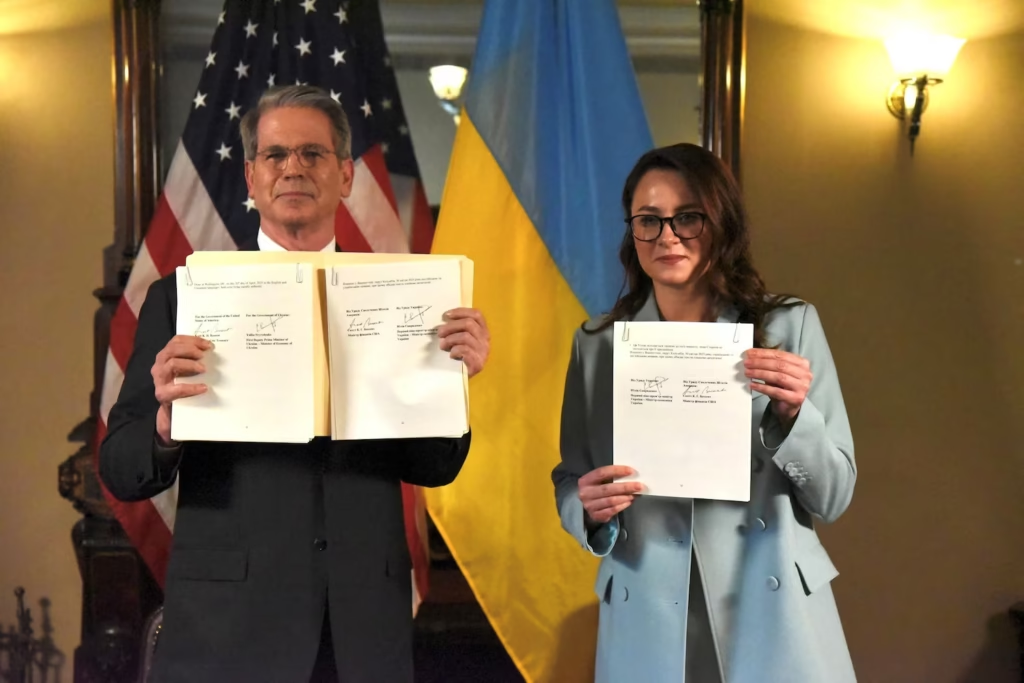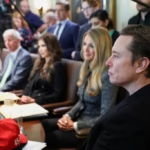On Wednesday, April 30, 2025, a historic and highly anticipated minerals-sharing deal was signed between the United States and Ukraine, marking a new chapter in the long-standing relationship between the two countries. This deal, which has garnered significant attention from both political analysts and the global community, promises to unlock Ukraine’s growth potential while ensuring that the U.S. continues to play a central role in shaping the country’s future. The signing of the agreement, which took place in Washington, D.C., followed months of tense negotiations and has been framed as a crucial development for the economic recovery of Ukraine, particularly as it rebuilds in the aftermath of Russia’s ongoing invasion.
U.S. Treasury Secretary Scott Bessent, who was instrumental in facilitating the deal, expressed his belief that this partnership would allow the United States to not only invest in Ukraine’s mineral-rich assets but also to leverage American expertise, capital, and governance standards to improve Ukraine’s investment climate. “This partnership allows the United States to invest alongside Ukraine to unlock Ukraine’s growth assets, mobilize American talent, capital, and governance standards that will improve Ukraine’s investment climate and accelerate Ukraine’s economic recovery,” said Bessent in a video announcing the deal.
Though the full details of the agreement have not been released, some key aspects have been previewed. Prime Minister Denys Shmyhal of Ukraine confirmed that the deal would not undermine Ukraine’s potential for accession to the European Union, a key goal for the country. He also stated that the agreement would not compromise Ukraine’s sovereignty or its future economic trajectory. The signing of this deal has been seen by many as a significant moment in the U.S.-Ukraine relationship, signaling a deeper commitment from the U.S. to invest in a free, democratic, and sovereign Ukraine.
For Ukraine, the agreement represents a vital opportunity to recover from the devastating effects of the ongoing war and move toward economic revitalization. Ukraine has long been known for its vast natural resources, particularly its mineral wealth, and this new partnership will allow the U.S. preferential access to these resources. These include critical materials like lithium and rare earth elements, which are essential for various high-tech industries, including electric vehicles and renewable energy production. By gaining access to these resources, the U.S. can further its own strategic goals while helping Ukraine rebuild its economy and strengthen its global position.
While the deal has been met with optimism by both American and Ukrainian officials, it has also raised concerns, particularly within Ukraine. Lawmakers from the Ukrainian parliament, known as the Rada, have expressed skepticism about the agreement, with some questioning the long-term implications for Ukraine’s sovereignty and economic independence. Oleksandr Merezhko, a lawmaker representing President Volodymyr Zelenskyy’s party, acknowledged that the agreement was better than its initial version but still expressed concern about its potential consequences. “I don’t know what we have signed,” said Merezhko, who chairs the parliament’s foreign affairs committee. “It’s too early to fully evaluate the agreement, but it seems like we have managed to avoid turning U.S. military aid into debt.”
This skepticism highlights the complex balancing act that Ukraine must undertake as it seeks to rebuild and recover from the war while maintaining its autonomy and independence. Ukraine’s push to join the European Union has been a cornerstone of its foreign policy, and there are concerns that this deal could complicate that effort. Some parliamentarians have raised the possibility that the U.S. could gain too much leverage over Ukraine’s economy, making it more difficult for the country to align with European standards and practices.
In contrast, U.S. officials have emphasized that the minerals-sharing deal is part of a broader strategy to support Ukraine’s recovery while ensuring that it remains an independent, sovereign nation. Treasury Secretary Bessent, in particular, framed the deal as a clear message to Russia that the U.S. is committed to Ukraine’s future. “This agreement is a clear signal that the U.S. is committed to a peace process centered on a free and sovereign Ukraine,” said Bessent. “We want the killing to stop, and the time for peace is now.” This rhetoric is part of the U.S. government’s broader efforts to counter Russian aggression in Eastern Europe and promote democratic values around the world.
The U.S. and Ukrainian governments have both framed this deal as a way to ensure that Ukraine remains a key player in the global economy, even as it recovers from the war. The signing of the agreement also comes at a time when Ukraine is looking for new sources of economic growth and stability. The war has devastated much of the country’s infrastructure, and economic recovery will require substantial investments in sectors such as energy, technology, and transportation. By partnering with the U.S. on the exploitation of Ukraine’s natural resources, Ukraine hopes to attract much-needed foreign investment and accelerate its recovery.
The deal, while historic, also comes with its share of political risks. Critics of the agreement argue that it could create an over-reliance on the U.S. for Ukraine’s economic growth, leaving the country vulnerable to external influence. Some have pointed out that this deal could ultimately weaken Ukraine’s ability to make independent decisions about its economic future. However, supporters of the agreement contend that the partnership with the U.S. provides Ukraine with a unique opportunity to rebuild its economy on its own terms, with the support of one of the world’s largest and most powerful economies.
The signing of the deal has also prompted a wave of reactions from various political figures and commentators. Dmitry Medvedev, the former president and current deputy chairman of Russia’s Security Council, framed the agreement as a defeat for Ukraine. Medvedev criticized the deal on social media, accusing Ukraine of “paying” for U.S. military aid with its mineral resources. “Now they will have to pay for military supplies with the national wealth of a disappearing country,” wrote Medvedev, underscoring the political dimensions of the minerals-sharing deal. Russia’s reaction to the agreement highlights the growing tensions between the West and Russia over Ukraine’s future, with Moscow seeking to assert its influence over the country’s political and economic direction.
Despite the criticism from Russia, U.S. officials have maintained that the deal is a win for both Ukraine and the U.S. and represents a long-term investment in Ukraine’s future. President Donald Trump, who has made Ukraine a central focus of his foreign policy, has emphasized that the agreement is part of the U.S.’s broader strategy to counter Russian aggression and support Ukraine’s recovery. Trump has expressed confidence that the minerals deal will not only help Ukraine rebuild its economy but also send a strong message to Russia that the U.S. is committed to supporting its allies in Eastern Europe.
As the agreement continues to unfold, it remains to be seen how it will impact Ukraine’s broader geopolitical ambitions, particularly with regard to its desire to join the European Union. Ukrainian lawmakers will likely continue to debate the deal’s terms in the coming weeks, with some pushing for more scrutiny and others expressing support for the economic opportunities it presents. Regardless of the political challenges, the minerals-sharing deal represents a new chapter in U.S.-Ukraine relations and signals a deeper commitment to the long-term success of Ukraine as a free and sovereign nation.
For the United States, the agreement represents a strategic investment in Ukraine’s future, offering both economic and geopolitical benefits. The U.S. will gain preferential access to Ukraine’s valuable mineral resources, which will help fuel its own industries while providing Ukraine with the resources it needs to rebuild. The deal also represents a symbolic commitment to Ukraine’s recovery, showcasing the U.S.’s ongoing support for the country in its struggle for sovereignty and independence.
As both countries move forward with the agreement, the next few months will be critical in determining whether the deal will live up to its promises. Ukraine’s economic recovery will depend on its ability to leverage its natural resources and attract foreign investment, and the U.S. will be watching closely to see how the deal impacts Ukraine’s long-term prospects. Ultimately, the success of the minerals-sharing agreement will depend on the ability of both countries to navigate the complexities of international diplomacy and build a lasting partnership that benefits both sides.


